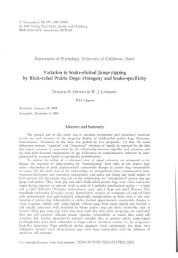Spring 2013 Program - Valdosta State University
Spring 2013 Program - Valdosta State University
Spring 2013 Program - Valdosta State University
You also want an ePaper? Increase the reach of your titles
YUMPU automatically turns print PDFs into web optimized ePapers that Google loves.
tHe coDe of acaDeMic regalia<br />
the colorful attire worn by the participants in the academic procession has its<br />
roots in medieval traditions that reach back to the earliest universities in paris,<br />
Bologna, oxford, and cambridge. the precise origins of the various parts<br />
that constitute academic garb are unknown; however, since medieval students<br />
enjoyed the status of clerics during their university years, we assume that their<br />
attire was inspired by the clerical dress of the time. early european universities<br />
required students and teachers to wear distinctive gowns at all times. the<br />
tradition of wearing similar attire was brought to the United states during<br />
colonial times, but the requirement for students to wear academic regalia soon<br />
disappeared and professors only donned their regalia during special occasions.<br />
The Gown<br />
the ceremonial robes—modernized with colors and varying sleeve lengths to<br />
signify degree and rank—began as monks’ robes worn to stave off the cold in<br />
drafty, cloistered monasteries. gowns are generally black, and there are three<br />
basic types. the bachelor’s gown is plain; includes long, pointed sleeves and<br />
may be worn with an elaborate yoke. the master’s gown is similar to the<br />
bachelor’s except that the sleeves are open at the forearms and end with an<br />
extra, square-shaped swatch of cloth that originally formed a pocket to store<br />
reading and writing materials. the doctoral gown, the most elaborate of the<br />
three, is adorned with velvet panels on the closed front and around the neck as<br />
well as three velvet chevrons on each full, bell-shaped sleeve. although black<br />
is the most common color of doctoral gowns, the velvet panels and chevrons<br />
may vary in color.<br />
The Hood<br />
the colors of the hood reveal the level of a degree, the major field of learning<br />
in which the degree was awarded, and the institution that conferred the<br />
degree. the bachelor’s, master’s, and doctoral hoods are three, three and onehalf,<br />
and four feet long, respectively. the all-encompassing velvet trim that<br />
denotes the field of learning is likewise two, three, or five inches, respectively.<br />
the lining of the hood is worn exposed to show the colors of the school<br />
awarding the degree. most schools have a two-color pattern and the hoods<br />
feature the use of chevrons or bars to differentiate schools whose colors may<br />
be alike or very similar.<br />
Colors Representing Fields of Learning<br />
arts, letters, Humanities White<br />
Business drab<br />
economics copper<br />
education light Blue<br />
engineering orange<br />
Fine arts Brown<br />
law purple<br />
library science lemon<br />
medicine green<br />
music pink<br />
nursing apricot<br />
oratory silver gray<br />
philosophy Blue<br />
public Health salmon<br />
physical education sage green<br />
science yellow<br />
social science citron<br />
theology scarlet<br />
The Cap<br />
generally, the mortarboard or oxford cap is worn with all degrees, although<br />
an elizabethan-style soft cap is used with some doctoral attire. Black tassels<br />
are most often used, but many schools have adopted the practice of using<br />
tassels that match the hood color. doctors and presidents of institutions<br />
frequently wear a gold tassel.<br />
38 | <strong>Valdosta</strong> state UniVersity spring <strong>2013</strong> commencement | 39












